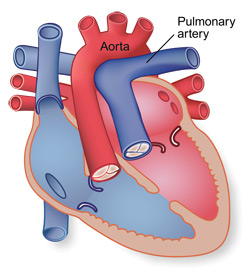The "great arteries" are the pulmonary artery and the aorta. Normally, the pulmonary artery is connected to the heart's lower-right chamber (the right ventricle). The right ventricle pumps oxygen-poor blood into the pulmonary artery, which carries that blood into the lungs. The lower-left chamber (the left ventricle) pumps oxygen-rich blood into the aorta, which carries that blood to the rest of the body.
 In transposition of the great arteries, the normal position of the arteries is reversed. The aorta comes out of the right ventricle (instead of the left), and the pulmonary artery comes out of the left ventricle (instead of the right). That means oxygen-rich blood returns to the lungs while oxygen-poor blood gets carried to the rest of the body.
In transposition of the great arteries, the normal position of the arteries is reversed. The aorta comes out of the right ventricle (instead of the left), and the pulmonary artery comes out of the left ventricle (instead of the right). That means oxygen-rich blood returns to the lungs while oxygen-poor blood gets carried to the rest of the body.
How is it treated?
A newborn baby may be given medicine called prostaglandin to keep the ductus arteriosus open. The ductus normally begins to close soon after birth, but keeping it open will allow some oxygen-rich blood to reach the body.
If the baby is not born with another defect that lets some oxygen-rich blood move through the body, doctors will actually create a defect called an atrial septal defect. In a procedure called balloon septostomy, a balloon-tipped catheter is used to create a hole in the wall that separates the right and left atria.
The medicines and the balloon septostomy are only short-term solutions, but they allow the body to get some oxygen-rich blood until surgery can be performed to correct the transposition.
The most common surgery for transposition of the great arteries can be performed within the first month of life. It is called an arterial switch and reverses the positions of the arteries, so that the pulmonary artery is connected to the right ventricle, and the aorta is connected to the left ventricle.
Return to main topic: Congenital Heart Disease
See on other sites:
MedlinePlus
https://medlineplus.gov/ency/article/001568.htm
Transposition of the great vessels
American Heart Association
www.heart.org/HEARTORG/Conditions/CongenitalHeartDefects/
AboutCongenitalHeartDefects/I-transposition-of-the-great-arteries_UCM_307031_Article.jsp
l-Transposition of the great arteries
www.heart.org/HEARTORG/Conditions/CongenitalHeartDefects/
AboutCongenitalHeartDefects/d-Transposition-of-the-great-arteries_UCM_307024_Article.jsp
d-Transposition of the great arteries
Texas Adult Congenital Heart Center (TACH)
www.bcm.edu/healthcare/care-centers/congenital-heart
This Baylor College of Medicine program enables patients with congenital heart disease to receive a seamless continuation of care from birth to old age.
Updated August 2016



